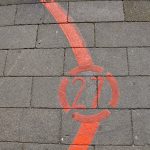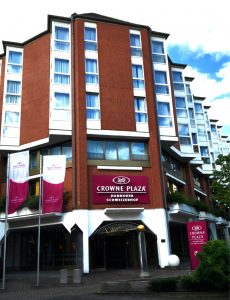It’s not always the big sights that leave a lasting impression. Sometimes it is rather a small story that stays in your mind, for example Hannover stories about a theft or cherries.
Story of the Stolen Golden Cookie
What an outcry in Hannover. At the beginning of 2013, a glance up at the company sign of the cookie manufacturer Bahlsen revealed that the golden Leibnitz cookie had disappeared. The press pounced on this story and quickly everyone was talking about the Cookie Monster crime story or Krümelgate.

But what had happened?
A beautiful company sign hangs on the façade of the cookie manufacturer. This was created in 1910 by the sculptor Georg Herting and shows two men (pretzel men) carrying a gold-plated Leibnitz cookie suspended in a pretzel. This cookie weighs about 20 kilograms and to be honest, it must not have been particularly easy to get the cookie loot off there.

The cookie is gone – and now?
It did not take long before the Bahlsen company and the Hannoversche Allgemeine Zeitung received a letter of confession. The blackmailing letter was accompanied by a photo of an unknown person in a Cookie Monster costume holding the cookie. The blackmailer(s) demanded that the Bahlsen company make a chocolate cookie donation to the children’s hospital on the Bult and donate the reward money (€1000 after all) to an animal shelter. If this did not happen, the cookie would end up in “Oskar’s dustbin”.
The Bahlsen company refused to meet the demands of the blackmail letter and offered a “substitute service”. They promised a generous cookie donation if the golden cookie was returned. Based on the number of cookie bags (52), they offered to donate 52,000 cookie bags to 52 social institutions.

The return and the fulfilment of the claims
The perpetrator(s) accepted the offer and agreed to return the Golden Cookie. On 5 February 2013, the cookie was attached with a red ribbon to the bronze statue of the Lower Saxony horse in front of Leibnitz University.

Just two days later, the blackmailer(s) asked the company’s management to make good on their promise. The company invited non-profit companies to apply for the cookies and drew lots for 52 lucky recipients to whom the cookies were delivered.
And the perpetrator(s)?
Although the cookie was forensically examined after it was returned and, of course, investigations into theft and extortion were underway, the police were unable to identify a culprit. The case was closed in May 2013.
To this day, speculation persists that the theft was a marketing campaign. Bahlsen denies this… Or was it a dare, a bet…?
But only the Cookie Monster will know what really happened….
Today, the cookie can be seen again in its original place.
The Geodetic Reference Point – or is the GPS right?
Behind the New Town Hall on the eastern platform facing the Maschteich and is marked by a 30 x 30cm floor plate the Geodetic Reference Point. But what is it?

Geodetic reference points are control points for checking so-called GNSS receivers. With the help of these receivers, coordinates can be determined that are needed to determine a location, for example with a GPS device. The control points are always located in places that are easily accessible to the public and are marked with fixed markings to the nearest centimetre. If you take the position of the small plate in Hannover, the coordinates are (reference system WGS84/ETRS89):
Geographical: Longitude: 09° 44.2819′ E
Latitude: 52° 21.9864′ N
UTM: East: 32 5 50 251.23 m
North: 58 02 052,35 m
Altitude: 53.64 m above sea level
If you want to check your own GPS device, go to the plate. Set the device to the reference system WGS84 or ETRS89. Now hold the GPS device over the centre of the plate and determine the location coordinates. Signals from 4 satellites should be received. The data displayed by the device should match the data on the ground plate with a maximum deviation of 3m-20m.
Hannover Stories about Cherries
Yes, cherries grow on trees – but stop! In Hannover, cherries also hang on house walls.
If you walk through the city, you will occasionally spot cherries on the walls of houses, especially in Nordstadt and in the Linden district. It all started a few years ago when wooden cherries were hung and nailed to trees in an art campaign. Shortly afterwards, first wooden cherries, later cherries made of Styrofoam and now even a “sticker variant” appeared on house walls.

It is unclear who is placing the cherries and why they are being placed.
Is there only milk in milk houses?
In the Georgengarten between Herrenhäuser Allee and Großer Garten stands a small house. The octagonal wooden pavilion dates from the 1920s. Here, needy working-class children could buy milk at a reasonable price. The aim was to combat rickets, which was widespread at the time.
Today there is a small café here where you can get drinks, ice cream and cakes in the summer months.
We heard Hanover stories during a research trip to Hanover.














Leave a Reply